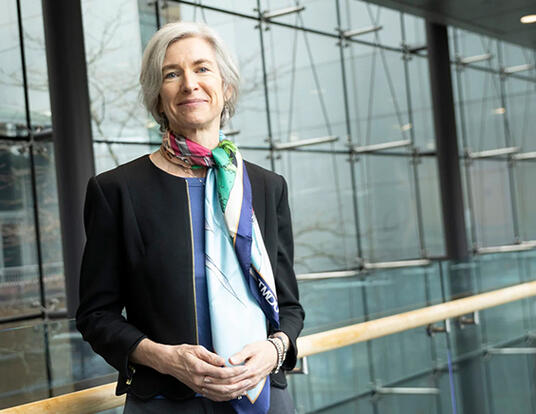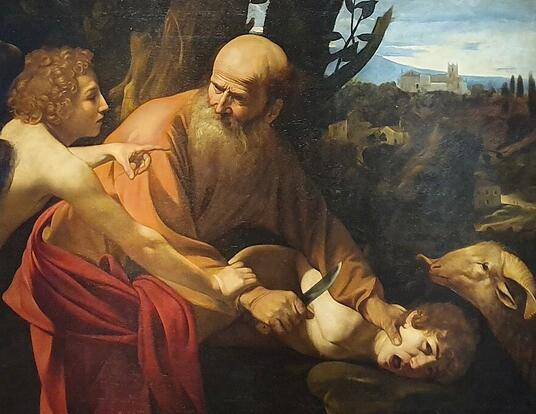Lifelong Curiosity: Alumni Day 2019
Alumni return to campus for a day of lectures and networking

Alumni Day is an annual celebration of scholarship across the disciplines, providing the opportunity for GSAS graduates of all generations to reconnect while reengaging with the innovative research undertaken by Harvard faculty. This year’s sessions covered a diversity of topics, from research on stem cells and molecular structure to legislative maps and narcissism in politics.
Improving Diversity Programs
Keynote speaker Frank Dobbin, professor of sociology, addressed an issue that concerns many who work in higher education: faculty diversity programs. “Why are we seeing disciplines across the country graduating women and minorities with PhDs but see so few earning tenure 10 years out?” he asked. “In analyzing data, we discovered that if you are female and Hispanic, each year you are more likely to leave academia than your white male colleagues. Something goes on in the career process that bumps up the exit rate.”
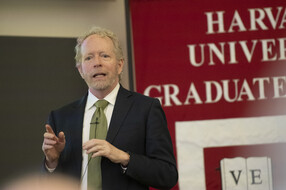
Dobbin explained that, according to his research, “blaming” or “threatening” faculty through mandatory trainings or grievance procedures proved ineffective. But, if faculty were given agency to engage with institutional task forces, or if they participated in mentoring programs, diversity and retention increased.
Formal mentoring programs are particularly effective, Dobbin says, because most faculty “step up” when asked to mentor a junior colleague. “Formal mentoring can ensure that anyone who wants a mentor gets one and it’s not expensive to do,” he said. “Mentors get the biggest boost and success out of the relationship.”
Cultural Influences
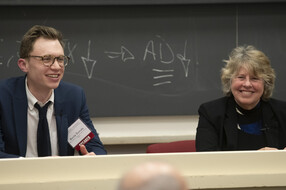
“Rethinking Modernism and the Museum: Picasso, Africa, and the West” brought together Suzanne Preston Blier and Kevin Tervala in a conversation about the academic and curatorial aspects of museums. Blier, Allen Whitehill Clowes Professor of Fine Arts and Professor of African and African American Studies, began by tracing the diverse cultural artifacts that Picasso might have referred to or have been influenced by in painting his famous Les Demoiselles d’Avignon (1907). In particular, she focused on the African masks that two of the women portrayed appear to be wearing, contesting the popular theory that the figures had initially been Caucasian, later effaced, and replaced with the African masks. Instead, she shows that Picasso intended the masks to be there from the painting’s conception, finding evidence that he had been influenced by work done by ethnographer Leo Frobenius and gynecologist Dr. C. H. Stratz.
Tervala, who is a PhD candidate in African and African American studies, drew on his work as art curator at the Baltimore Museum of Art (BMA). Blier pointed out that typical museum layouts organize works of art by continents. She wants museums to question this approach and give visitors a sense of the cross-cultural influences on artists and their works of art. While at the BMA, Tervala was involved in efforts to demonstrate the reciprocal influences of Europe and Africa on each other’s art scene. His experience as an art curator enables him to take a step back from his graduate work and approach it with new eyes.
Repairing Trauma

Amy Wagers, Forst Family Professor of Stem Cell and Regenerative Biology, works to understand the fundamental mechanisms that regulate stem cells in the body and ultimately apply this knowledge to the treatment of human diseases. When stem cells are not functioning properly, they can affect the resiliency of our tissues, particularly their ability to recover from injury. One of the tissues Wagers focuses on is skeletal muscle, which is integral to our bodies’ movement and structural stability.
In “Stem Cell– and Gene-Based Strategies to Promote Muscle Repair and Function,” Wagers explained that while most cells contain a single nucleus, muscle fiber cells are multinucleated, formed when cells fuse together. This makes muscle recovery after injury tricky. Satellite stem cells sit close to the muscle fibers and are the functional units of muscle regeneration after injury. When these cells sense damage, they divide, differentiate into muscle cells and repair the trauma.
Work in mice has shown that these muscle stem cells lose robustness with age: The more cycles of injury and repair they experience, the slower their ability to regenerate a muscle. This is acutely felt in people with Duchenne muscular dystrophy (DMD), who lack a functioning shock-absorber protein called dystrophin that provides strength during muscle contraction. Wagers is working on ways to increase the amount of this protein in a mouse model called mdx, which has a defective dystrophin, using gene therapy. The initial results have been promising, but she noted that there is still work to do.
Fair Representation

In “Social Science in the Courtroom: The Fight for Fair Representation,” Stephen Ansolabehere, PhD ’89, government, Frank G. Thomson Professor of Government, showed how new map-making technologies have enabled communities impacted by partisan gerrymandering to bring suits over redistricting. Ansolabehere discussed his contributions to recent redistricting cases, explaining that advances in technology such as GIS have been transformative. These tools enable Ansolabehere to use data to create a narrative that explains what happened, who was harmed, and what could be done to fix that harm.
One example Ansolabehere shared was a case in Florida, which passed a new legislative map in 2012. The map contained a strangely shaped district that snaked along a river from Jacksonville to Orlando, capturing a low income, African American population. Using new data-driven tools for districting, he was able to prove that a better and more fair distribution between Republicans and Democrats was possible. During the subsequent court case, it was found that the state government had started with this map then deliberately redrew it to benefit Republicans.
Ansolabehere said that new technologies have enabled those who were disempowered in the past to have a voice in government and in the courts.
Course Choice
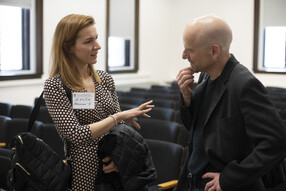
In “Curricle: A Revolution in Curricular Exploration and Discovery,” Jeffrey Schnapp, Carl A. Pescosolido Professor of Romance Languages and Literatures and of Comparative Literature, introduced Curricle, a re-envisioning of the course catalog. Curricle enables students to explore past and present curricula, search courses by keywords, and plan semester schedules. Informed by a spirit of experimentation, the design of Curricle enables viewers to see how courses, disciplines, and instructors are connected, thus promoting a culture of curricular curiosity. It also enables students to share their course discovery process with their advisors and peers, as well as chart their academic trajectory. This helps students make more informed curricular decisions with access not only to past courses, but also to past fields and departments.
Molecular Behavior
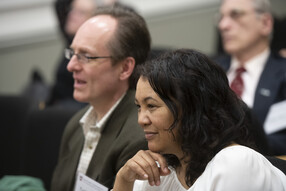
Stephen Harrison, PhD ’68, biophysics, the Giovanni Armenise–Harvard Professor of Basic Biomedical Science, began his talk, “Viruses, Proteins, and Cells,” with an overview of how scientists transitioned from studying cells to studying molecules. “Biology has always been a study of structure,” said Harrison, but new tools have added to our ability to look at a structure from various angles. Additionally, these new techniques allow scientists to see how complex structures change over time.
Harrison used these cutting-edge techniques to investigate how rotavirus enters human cells. Rotavirus causes severe diarrhea in young children and is responsible for the deaths of an estimated 215,000 children under five each year. The structure of rotavirus looks like a ball with regularly spaced spikes. Analyzing the spike protein through X-ray crystallography, Harrison found that the protein changes conformation, which suggests that it experiences a change in structure.
Harrison and his team recently realized that this change led the spike protein to thrust its “foot,” normally found inside the rotavirus, out, which suggests that the “foot” is doing something to the membrane that allows rotavirus to enter these cells. What that ‘something’ is, is being investigated.
For Harrison, the advances that the field has experienced will allow scientists to better understand what these molecules look like and how they behave.
Underlying Issues
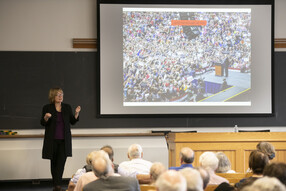
In “Narcissism in Public Life: Can Perspectives from the Past Illuminate the Present?” Elizabeth Lunbeck, PhD ’84, history, professor of the history of science in residence, discussed how narcissism in politics is understudied, undervalued, and underutilized in public discussion about politics. Lunbeck explored the reasons that regular people can be swayed by a narcissistic, authoritarian leader.
Using Adolf Hitler and Germany in the 1930s as an example, Lunbeck pointed to contemporaneous accounts of Hitler that described the way in which he was able to whip up a crowd’s enthusiasm. Writers at the time described Hitler as saying what his supporters felt but didn’t know how to put it into words. While Hitler is remembered as a narcissist, his talent for connecting to his audience’s deep-seated fears is less frequently discussed.
Today, Lunbeck believes that too much attention is placed on President Donald Trump as a narcissist and not enough on his supporters’ belief in him and the emotions he brings up in them. She says that Trump connects with people who feel powerless, promising transition and movement out of their circumstances, even though the result could ultimately be disadvantageous for them. Facts, Lunbeck concludes, are impotent in the face of strong emotions.
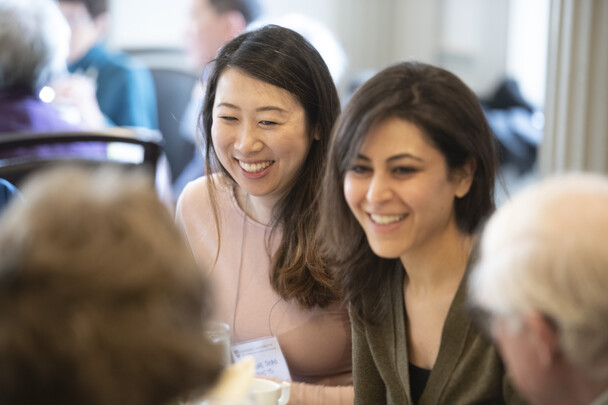
Save the date for Alumni Day 2020 on April 4!
Photos by Tony Rinaldo
Get the Latest Updates
Join Our Newsletter
Subscribe to Colloquy Podcast
Simplecast Stitcher


